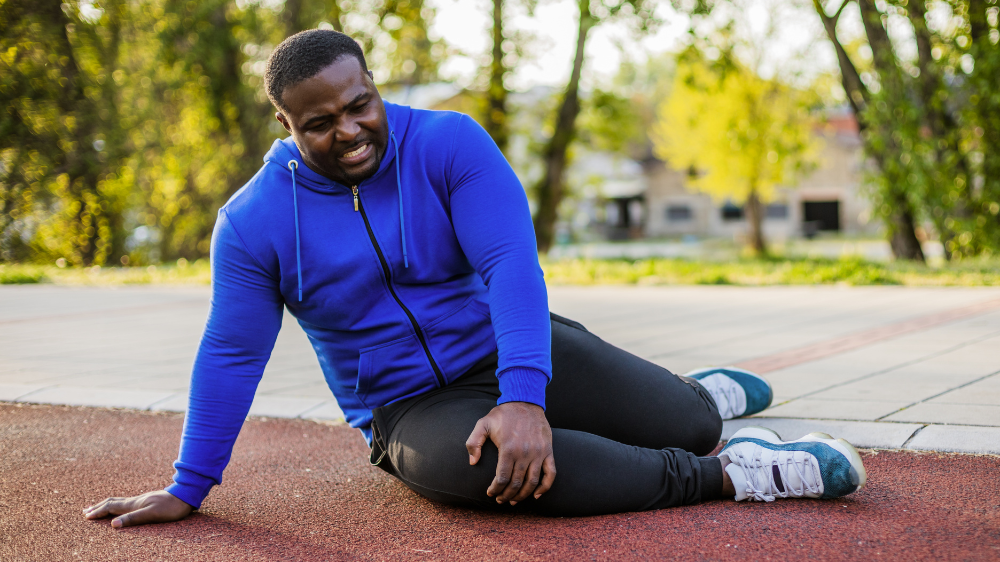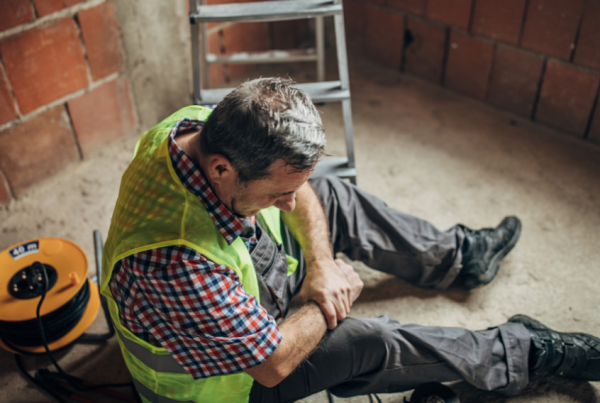Sports Injuries
Move Better. Live Fuller. Your Wellness Journey Starts Here.
Schedule a FREE Discovery Call!
About Sports Injuries
Sports injuries are very common and can occur in practically any sport due to a variety of reasons. These injuries can range from mild to severe, and may be acute or chronic.
Sports injuries commonly affect the musculoskeletal system, meaning they affect the bones, muscles, ligaments, and tendons. These types of injuries are best suited to physical therapy treatment, which aims to restore function, comfort, mobility and flexibility to the body—although physical therapy can also be useful for other injuries such as concussions.
Some examples of common sports injuries include:

- Sprains or strains
- Fractures
- Joint dislocations
- Tendonitis
- Overuse injuries
- Bursitis
- And more
As mentioned before, sports injuries can be either acute or chronic. These terms don’t refer to the severity of the injury or symptoms, but rather the length of time that they occur. Acute injuries are short-term, usually sudden injuries, such as those that occur after direct impact or a fall. Chronic injuries refer to those that are long lasting. Sports injuries like tendonitis, bursitis, or overuse injuries can become chronic when not properly addressed, as they worsen over time.
Every sport is different and demands different skills, but many of the root causes of sports injuries are similar. We’ll take a closer look at these causes next!
Common Causes of Sports Injuries
Sports injuries can occur to anyone, whether you are playing recreationally or professionally, for a variety of different causes. These causes are usually due to one of three things: The nature of the sport itself, your performance and preparation, and environmental factors. Here are some examples below:
Direct Impact
Events such as collisions or falls can cause fractures, concussions, dislocations, and other injuries. These can range widely, but may cause serious injury.
Overuse
If you play sports very often as a hobby or as a career, your body is likely performing the same movements over and over again. These repetitive movements, over time, can put a lot of strain and friction on whichever parts of the body is being used. Some examples include kicking, climbing, swinging, and more.
Overtraining / Overextension
Pushing your body past what it is capable of is a fast path towards injury. This can be things like training for too long without adequate rest, increasing the intensity or difficulty of your training too quickly, or even just trying to lift more weight than you can handle. This fatigues your muscles and even your mind—and makes injury much more likely.
Poor Form or Technique
Having poor movement mechanics, posture, and technique during your sport can create injury. For example, if you have not learned to land a jump properly, you are much more likely to experience sprains or strains.
Muscle Imbalances
Your body’s muscles don’t work independently. When you play any sport, multiple muscle groups must coordinate to properly provide speed, power, balance, and agility. If your body’s muscle groups are imbalanced, they will be less likely to coordinate and perform efficiently, which can lead to injury. For example, you can have a strong core, but if your back, hips, or pelvic floor are not strong as well, you may experience injury during movements such as lifting.
Insufficient Conditioning
Warming up your body before playing a sport is incredibly important. Not only does it reduce the risk of injury, but it also gets your body better prepared to perform. Stretching and performing light exercise before a sport can significantly reduce your risk of injury.
Inadequate Equipment / Environmental Factors
In some cases, your equipment or environment may be the cause of injury. Broken or old equipment is dangerous to use or rely on. Additionally, it is a good idea to check your playing environment for any hazards beforehand (holes on a playing field, broken court pavements, etc.).
Regardless of the type of injury you experience, physical therapy plays a very important role in management, recovery, and prevention. We’ll discuss how in the next section!
Physical Therapy for Sports Injuries
Physical therapy is a primary form of treatment for sports injuries. Physical therapy treatment can address pain, restore function and comfort, assist with surgical rehabilitation, and prevent future injury. Your Hive physical therapist will perform a thorough evaluation and examination to identify your needs or causes of your condition, and then curate a comprehensive plan of care to best address those needs.
The evaluation will explore the specifics of your sport, your symptoms, and other related information, such as:
- How your injury occurred / the type of injury
- The severity of the injury and how it limits daily function
- Any related previous injuries or medical conditions
- The type of sport, how often you play, and any changes in training
In terms of examination, your physical therapist will observe your unique symptoms, evaluate your range of motion, and test the function of the affected area. Depending on your injury, your physical therapist may evaluate your strength and sports performance through physical testing and other activities.
Once your physical therapist has a thorough understanding of your injury and specific needs, they’ll perform a variety of treatments, such as the following:
Pain Management
Physical therapists are able to provide a variety of pain-relieving treatments, whether you have an acute or chronic sports injury. They can address pain, inflammation, swelling, and scar tissue through manual therapy and other treatments like temperature therapy, electric muscle stimulation, and more.
Manual therapy is especially useful for sports injuries, as this type of treatment not only relieves pain but also improves range of motion, muscle function, and blood flow to support healing and mobility.
Neuromuscular Re-Education
For many injuries, especially more severe types that require surgery, neuromuscular re-education will be necessary to restore movement patterns, coordination, and muscle activation. This treatment will make your movements more natural and efficient, which will decrease your risk of injury. You’ll be better able to coordinate and activate your muscle groups as needed for your unique sport!
Strengthening and Flexibility
Sports injuries can result in stiffness, reduce range of motion, and weak muscles when not rehabilitated properly. This can impact both your health and your performance. In order to restore optimized function, your physical therapist will gradually introduce strengthening exercises, mobility exercises, and stretches that target the affected area and supporting structures. These activities will be catered to the severity and needs of your unique sports injury, and will become progressively more challenging as you heal.
This strengthening and stretching plan will incorporate tasks and activities that improve movements specific to your sport, while restoring general health, muscle balance, and range of motion to the affected area. Strengthening the area and improving flexibility has many benefits. It restores your general health after injury and prevents re-injury. Both of these aspects are incredibly important in order for you to return to playing with enhanced performance.
Functional Training
While the root causes of sports injuries are similar, each sport requires different movements that can lead to a variety of injuries. Therefore, your physical therapist will be sure to improve many different physical factors directly related to your unique sport, such as:
- Movement mechanics
- Posture and form
- Stability and muscle coordination
- Gait and sports-specific techniques like jumping, landing, and more
- Joint stability
Work with Hive confidently knowing that our physical therapists are experts of the body. They are extremely knowledgeable, highly trained, and very dedicated to providing comprehensive treatment. They’ll ensure that you not only feel great again, but are prepared to play your sport with a reduced risk of injury.
Education and Prevention
An important part of treatment for sports-related injuries is education and prevention. To maintain good health after recovery and to prevent re-injury, your physical therapist will be sure to determine any imbalances in your warm-up technique or cool-down methods. They’ll make corrections as needed, and teach other important aspects such as proper progression of your training intensity, how to avoid overexertion, and more.
Your physical therapist will send you home with an exercise plan designed to support long-term health and performance. Additionally, your Hive provider can collaborate with your athletic trainers, coaches, and other sports or health professionals as needed to best support your individual needs and goals.
As mentioned before, the physical therapists at Hive Therapy and Wellness are very dedicated to providing holistic care. They’ll curate your treatment plan to your individual needs and unique sport, using whichever treatments best address the cause of your injury or symptoms. While receiving physical therapy for sports injuries, you may experience any of the following treatment methods:
- Neuromuscular re-education
- Manual therapy
- Exercise prescription
- Dry needling
- Cupping
- Tissue scraping
- Behavioral modifications
- Therapeutic activities
- Electrical muscle stimulation
- Spinal manipulation
- Therapeutic modalities
- Biofeedback
Sports injuries are very common and can occur in practically any sport due to a variety of reasons. These injuries can range from mild to severe, and may be acute or chronic.
Sports injuries commonly affect the musculoskeletal system, meaning they affect the bones, muscles, ligaments, and tendons.
These types of injuries are best suited to physical therapy treatment, which aims to restore function, comfort, mobility and flexibility to the body—although physical therapy can also be useful for other injuries such as concussions.
Some examples of common sports injuries include:
- Sprains or strains
- Fractures
- Joint dislocations
- Tendonitis
- Overuse injuries
- Bursitis
- And more
As mentioned before, sports injuries can be either acute or chronic. These terms don’t refer to the severity of the injury or symptoms, but rather the length of time that they occur.
Acute injuries are short-term, usually sudden injuries, such as those that occur after direct impact or a fall. Chronic injuries refer to those that are long lasting.
Sports injuries like tendonitis, bursitis, or overuse injuries can become chronic when not properly addressed, as they worsen over time.
Every sport is different and demands different skills, but many of the root causes of sports injuries are similar. We’ll take a closer look at these causes next!
Sports injuries can occur to anyone, whether you are playing recreationally or professionally, for a variety of different causes.
These causes are usually due to one of three things: The nature of the sport itself, your performance and preparation, and environmental factors. Here are some examples below:
Direct Impact
Events such as collisions or falls can cause fractures, concussions, dislocations, and other injuries. These can range widely, but may cause serious injury.
Overuse
If you play sports very often as a hobby or as a career, your body is likely performing the same movements over and over again.
These repetitive movements, over time, can put a lot of strain and friction on whichever parts of the body is being used. Some examples include kicking, climbing, swinging, and more.
Overtraining / Overextension
Pushing your body past what it is capable of is a fast path towards injury.
This can be things like training for too long without adequate rest, increasing the intensity or difficulty of your training too quickly, or even just trying to lift more weight than you can handle. This fatigues your muscles and even your mind—and makes injury much more likely.
Poor Form or Technique
Having poor movement mechanics, posture, and technique during your sport can create injury. For example, if you have not learned to land a jump properly, you are much more likely to experience sprains or strains.
Muscle Imbalances
Your body’s muscles don’t work independently. When you play any sport, multiple muscle groups must coordinate to properly provide speed, power, balance, and agility.
If your body’s muscle groups are imbalanced, they will be less likely to coordinate and perform efficiently, which can lead to injury. For example, you can have a strong core, but if your back, hips, or pelvic floor are not strong as well, you may experience injury during movements such as lifting.
Insufficient Conditioning
Warming up your body before playing a sport is incredibly important.
Not only does it help reduce the risk of injury, but it also gets your body better prepared to perform. Stretching and performing light exercise before a sport can significantly reduce your risk of injury.
Inadequate Equipment / Environmental Factors
In some cases, your equipment or environment may be the cause of injury. Broken or old equipment is dangerous to use or rely on.
Additionally, it is a good idea to check your playing environment for any hazards beforehand (holes on a playing field, broken court pavements, etc.).
Regardless of the type of injury you experience, physical therapy plays a very important role in management, recovery, and prevention. We’ll discuss how in the next section!
Physical therapy is a primary form of treatment for sports injuries. Physical therapy treatment can address pain, restore function and comfort, assist with surgical rehabilitation, and prevent future injury.
Your Hive physical therapist will perform a thorough evaluation and examination to identify your needs or causes of your condition, and then curate a comprehensive plan of care to best address those needs.
The evaluation will explore the specifics of your sport, your symptoms, and other related information, such as:
- How your injury occurred / the type of injury
- The severity of the injury and how it limits daily function
- Any related previous injuries or medical conditions
- The type of sport, how often you play, and any changes in training
In terms of examination, your physical therapist will observe your unique symptoms, evaluate your range of motion, and test the function of the affected area.
Depending on your injury, your physical therapist may evaluate your strength and sports performance through physical testing and other activities.
Once your physical therapist has a thorough understanding of your injury and specific needs, they’ll perform a variety of treatments, such as the following:
Pain Management
Physical therapists are able to provide a variety of pain-relieving treatments, whether you have an acute or chronic sports injury.
They can address pain, inflammation, swelling, and scar tissue through manual therapy and other treatments like temperature therapy, electric muscle stimulation, and more.
Manual therapy is especially useful for sports injuries, as this type of treatment not only relieves pain but also improves range of motion, muscle function, and blood flow to support healing and mobility.
Neuromuscular Re-Education
For many injuries, especially more severe types that require surgery, neuromuscular re-education will be necessary to restore movement patterns, coordination, and muscle activation.
This treatment will make your movements more natural and efficient, which will decrease your risk of injury. You’ll be better able to coordinate and activate your muscle groups as needed for your unique sport!
Strengthening and Flexibility
Sports injuries can result in stiffness, reduce range of motion, and weak muscles when not rehabilitated properly. This can impact both your health and your performance.
In order to restore optimized function, your physical therapist will gradually introduce strengthening exercises, mobility exercises, and stretches that target the affected area and supporting structures.
These activities will be catered to the severity and needs of your unique sports injury, and will become progressively more challenging as you heal.
This strengthening and stretching plan will incorporate tasks and activities that improve movements specific to your sport, while restoring general health, muscle balance, and range of motion to the affected area.
Strengthening the area and improving flexibility has many benefits. It restore your general health after injury and prevents re-injury. Both of these aspects are incredibly important in order for you to return to playing with enhanced performance.
Functional Training
While the root causes of sports injuries are similar, each sport requires different movements that can lead to a variety of injuries.
Therefore, your physical therapist will be sure to improve many different physical factors directly related to your unique sport, such as:
- Movement mechanics
- Posture and form
- Stability and muscle coordination
- Gait and sports-specific techniques like jumping, landing, and more
- Joint stability
Work with Hive confidently knowing that our physical therapists are experts of the body. They are extremely knowledgeable, highly trained, and very dedicated to providing comprehensive treatment.
They’ll ensure that you not only feel great again, but are prepared to play your sport with a reduced risk of injury.
Education and Prevention
An important part of treatment for sports-related injuries is education and prevention.
To maintain good health after recovery and to prevent re-injury, your physical therapist will be sure to determine any imbalances in your warm-up technique or cool-down methods.
They’ll make corrections as needed, and teach other important aspects such as proper progression of your training intensity, how to avoid overexertion, and more.
Your physical therapist will send you home with an exercise plan designed to support long-term health and performance.
Additionally, your Hive provider can collaborate with your athletic trainers, coaches, and other sports or health professionals as needed to best support your individual needs and goals.
As mentioned before, the physical therapists at Hive Therapy and Wellness are very dedicated to providing holistic care.
They’ll curate your treatment plan to your individual needs and unique sport, using whichever treatments best address the cause of your injury or symptoms. While receiving physical therapy for sports injuries, you may experience any of the following treatment methods:
- Neuromuscular re-education
- Manual therapy
- Exercise prescription
- Dry needling
- Cupping
- Tissue scraping
- Behavioral modifications
- Therapeutic activities
- Electrical muscle stimulation
- Spinal manipulation
- Therapeutic modalities
- Biofeedback
You can learn more about these treatments on our Treatments Page.





